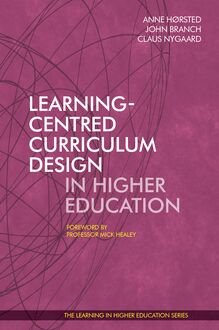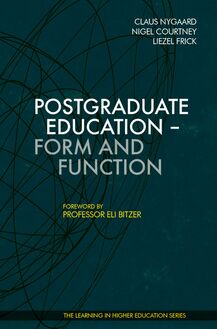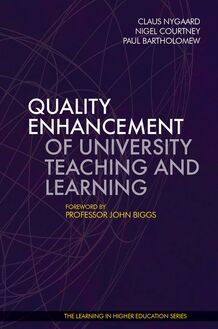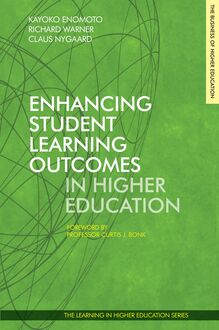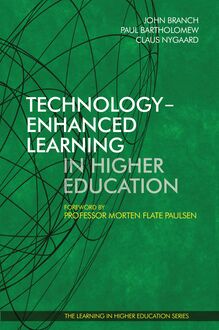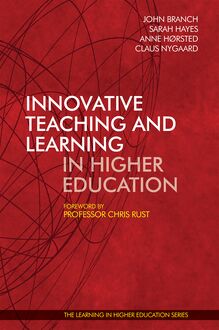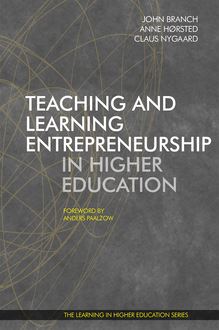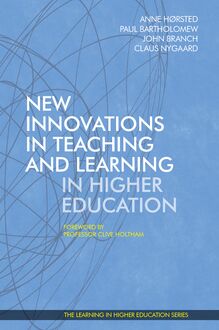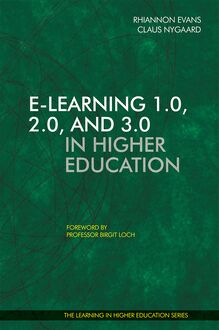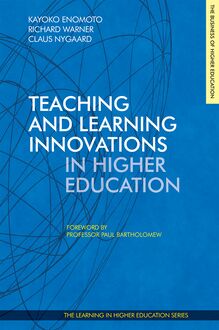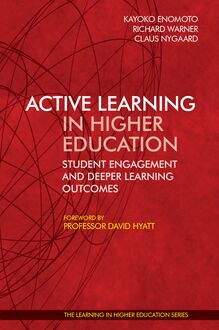-
 Univers
Univers
-
 Ebooks
Ebooks
-
 Livres audio
Livres audio
-
 Presse
Presse
-
 Podcasts
Podcasts
-
 BD
BD
-
 Documents
Documents
-
- Cours
- Révisions
- Ressources pédagogiques
- Sciences de l’éducation
- Manuels scolaires
- Langues
- Travaux de classe
- Annales de BEP
- Etudes supérieures
- Maternelle et primaire
- Fiches de lecture
- Orientation scolaire
- Méthodologie
- Corrigés de devoir
- Annales d’examens et concours
- Annales du bac
- Annales du brevet
- Rapports de stage
La lecture à portée de main
Découvre YouScribe en t'inscrivant gratuitement
Je m'inscrisDécouvre YouScribe en t'inscrivant gratuitement
Je m'inscrisEn savoir plus
En savoir plus

Description
The latest volume in the Learning in Higher Education series, Teaching and Learning Innovations in Higher Education showcases transformative, theory-informed innovations in teaching and learning in Higher Education. It presents a brand new, unique perspective on innovation in HE - the Learning-centred Five-tier Model of Innovation - which guides educators in their innovation of teaching and learning products, processes, or services. A distinguishing feature of the book is the linkage to the Five-tier Model of Innovation that explicitly relates to three learning paradigms: Instructivism, Cognitivism, and Constructivism. In each chapter, authors situate their teaching and learning innovations in one of the three learning paradigms. The book contains twenty-one inspiring cases showing learning-centred product, process, or service innovations within five focus areas: Learning Space Design - E-Learning - Case-Methodology - Business Practice and Fieldwork - Creative Methodologies - Reflective Methodologies.
Informations
| Publié par | Libri Publishing Ltd |
| Date de parution | 28 février 2021 |
| Nombre de lectures | 2 |
| EAN13 | 9781912969432 |
| Langue | English |
| Poids de l'ouvrage | 5 Mo |
Informations légales : prix de location à la page 0,2650€. Cette information est donnée uniquement à titre indicatif conformément à la législation en vigueur.
Extrait
Teaching and Learning
Innovations in
Higher EducationTeaching and Learning
Innovations in
Higher Education
Kayoko Enomoto, Richard Warner and Claus Nygaard
THE INNOVATIONS IN HIGHER EDUCATION SERIESFirst published in 2021 by Libri Publishing
Copyright © Libri Publishing
Authors retain copyright of individual chapters.
Te right of Kayoko Enomoto, Richard Warner and Claus Nygaard to be
identifed as the editors of this work has been asserted in accordance with the
Copyright, Designs and Patents Act, 1988.
print ISBN 978-1-911450-73-3 eISBN 978-1-912969-43-2
All rights reserved. No part of this publication may be reproduced, stored in any
retrieval system or transmitted in any form or by any means, electronic,
mechanical, photocopying, recording or otherwise, without the prior written permission
of the copyright holder for which application should be addressed in the frst
instance to the publishers. No liability shall be attached to the author, the
copyright holder or the publishers for loss or damage of any nature sufered as a result
of reliance on the reproduction of any of the contents of this publication or any
errors or omissions in its contents.
A CIP catalogue record for this book is available from Te British Library
Cover design by Helen Taylor
Design by Carnegie Publishing
Libri Publishing
Brunel House
Volunteer Way
Faringdon
Oxfordshire
SN7 7YR
Tel: +44 (0)845 873 3837
www.libripublishing.co.ukContents
Foreword ix
Paul Bartholomew
Chapter 1: What Drives Teaching and Learning Innovations
in Higher Education? 1
Kayoko Enomoto, Richard Warner and Claus Nygaard
Chapter 2: A Learning-centred, Five-tier Model of
Innovation in Higher Education 19
Eva Dobozy and Claus Nygaard
Chapter 3: Is Higher Education Ready for the Transformed
Learner Coming from 9–12? A Case Study 47
Lennie Scott-Webber, Pam Loefelman, Dennis Runyan and
Marilyn Denison
Chapter 4: Flexible Classroom Design to Facilitate Learning,
Engagement and Integration of Knowledge and Cultures 83
Elena Forasacco
Chapter 5: Emergency Remote Teaching in Interior
Architecture: A Necessary Shift 109
Selin Ust
Chapter 6: Best Practices of Teaching Diverse Cohorts
in a Webcam-enabled Virtual Environment 129
Kristina Rigden
Chapter 7: Impacts of Using Technology-Enhanced
Language Learning in Second Language Academic Writing
at a Vietnamese University 147
Henriette van Rensburg and Triet Tanh La
Chapter 8: Using Arts-based Instructional Strategies in
E-learning to Increase Students’ Social-emotional
Learning Outcomes 173
Beth Perry and Margaret Edwards
v C ont e nt s
Chapter 9: Using a Community of Inquiry Framework to
Foster Students’ Active Learning 195
Giovanna Carloni
Chapter 10: An Innovative Assessment Method to Evaluate
Independent Learning and Academic Writing Skills 209
Richard Warner and Kayoko Enomoto
Chapter 11: Afrm–Apply–Advance: Transitioning
Undergraduate Students through their Teory-into-
practice Journey 233
Michelle Bissett and Melanie Roberts
Chapter 12: An Innovative Model for University-Industry
Collaboration in Course Design and Delivery 257
Sami Heikkinen
Chapter 13: Project-Based Learning in a Japanese University:
A Disruptive Innovation in Business Education 273
Sarah Louisa Birchley, Keiko Omura and Kayoko Yamauchi
Chapter 14: Facilitating Active Student Learning Using
Innovative Approaches in Pre-Service Teacher Education 301
Lana YL Khong
Chapter 15:
Innovative Assessment in Higher Education: A Public
Dissemination Assessment Model for Language Students 323
Rhiannon Evans
Chapter 16: Teaching from the Native American Circle:
An Innovative Teaching Framework 339
Diana Schooling
Chapter 17: Discovering Professional Musician Identity
through Refective Narrative Writing: A Case Study of
Pedagogic Profciency 357
Jennifer Rowley
viContents
Chapter 18: Using Fiction and Non-fction Literature to
Teach Sensitive Health Issues in Teacher Education 375
Brenda Kalyn, Beverley Brenna and Judy Jaunzems-Fernuk
Chapter 19: Collaborative Enquiry-based Learning in an
Oral Health Program 405
Hanna Olson
Chapter 20: Transformative Inquiry through the
Human Curriculum 425
Judy Jaunzems-Fernuk, Stephanie Martin and Brenda Kalyn
Chapter 21: Using Cross-disciplinary Object-based
Learning to Create Collaborative Learning Environments 451
Judy Willcocks and Silke Lange
Chapter 22: Building Employability Skills through
Collaborative Group Work 475
Sarah Swann
viiviiiForeword
Academic Innovation as a
Strategic Act
Paul Bartholomew
I should frst of all acknowledge that I have a long association with the
LiHE series of books, having written about a dozen chapters in the past
and have edited about half a dozen of the books. Tat of course means
that I have attended a number of the symposia, which I have found to be
immensely valuable for my own personal development.
For me, the value of the LiHE book-writing process is multifaceted.
Firstly, it yields a book – a compendium of practice accounts that are
refective, articulated with theory and are practice-based; these accounts
are useful to others and have the opportunity to multiply the impact of
innovative academic practice through wide dissemination. Secondly, the
process of refecting on one’s work and ‘writing it up’ in a format such
as this adds new value for the innovator-author; indeed, I have found
that part of the process to be transformative. Tirdly, the LiHE process
gives an opportunity for the innovator-author to immerse themselves in
a community of practice and to grow as a result.
Consequently, because of my association with LiHE, I was delighted
to be asked to provide a foreword for this book, not least because the
methods used to replicate the ‘LiHE process’ this year has had to be
innovatively adapted to meet the needs of the contemporaneous Covid-19
context. Te innovation-upon-innovation context is laudable and, as I
discuss below, resonant with our sector’s higher education strategic needs.
As the Vice-Chancellor of one of the United Kingdom’s most complex
large universities, I have a strategic interest in academic innovation. If ever
there was a time when higher education teaching needed to adopt
innovative approaches and bolster innovation capacity – it has been during this
period of the global pandemic.
But more generally I would contend that we, as universities, need
innovators – we need to grow them, nurture them and reward them.
Modern higher education is characterised by its need to be cutting edge,
agile, (necessarily) efcient and (most of all) demonstrably efective. Tat
ixForeword
requires an institutional capacity for innovation – and where does that
innovation come from? Our people.
Individual propensity for innovation leads to institutional capacity for
innovation. An investment in personal/personnel development to bolster
the propensity for innovation is an investment in future gains on the
bottom line, future gains in our students’ experiences and indeed future
gains in the quality of the working lives of staf/faculty. It is a win-win
scenario.
So, can innovation as an academic practice be taught and/or
strategically supported? Yes it can. At two universities, over the course of more
than a decade, I have run staf/faculty development courses teaching how
to become an innovator in higher education. Tose courses have had a
signifcant impact to individuals’ capability for innovation, and thus for
their institution’s capacity to respond to desirable change and by so doing
enhance the experiences of students and faculty and deliver business
success.
As manager/leader in higher education, I know only too well the
responsibility I have to set a context that nurtures the innovative
capabilities of our faculty and other staf. Broadly, innovators will thrive in
environment where they are ‘willing’, ‘able’ and ‘allowed’ to innovate.
To bolster ‘willing’ we need to ensure innovation is not penalised –
we have a management responsibility to ensure the risk-taking that goes
hand-in-hand with doing things diferently is not discouraged. Indeed,
we might consider incentivising innovation by making reference to it
within the criteria for promotion.
To bolster ‘able’, we have to invest in staf/faculty development and
we need to acknowledge that this investment can be direct – through the
provision of courses, and indirect as we invest in staf/faculty so that they
can participate in their community of practice – for example by ensuring
development time is included within any workload allocation
consideration and that travel and subsistence funds are available for participation
in events such as LiHE book writing symposia (for example).
To bolster ‘allowed’, we need to look to our management practices
and take steps to ensure that the nurturing-of-innovation perspective is
operationalised within the full depth of the management strata within
the university. From experience, I know that this is the most critical thing
to get right.
xForeword
Succeed in supporting staf/faculty to be ‘able’, ‘willing’ and ‘allowed’
to innovate and step towards success as a university.
I have contended above that innovators in higher education add real
business value to their universities – this becomes all too apparent as one
looks at the foci of the chapters in this book: how to use learning spaces
efectively; preparing a pipeline of potential students; coping with
Covid19; student motivation; efective use of technology; collaborative practice;
curriculum design; creativity; assessment design; identity; and evaluating
the efcacy of a range of pedagogical approaches. All vital things for a
university to do well.
If you are university leader, these author-innovators (and those myriad
of fellow pedagogic innovators around the world) are the R&D wing of
your teaching business, the solvers of some of your academic operations
problems and a vital part of the life -blood
-
 Univers
Univers
-
 Ebooks
Ebooks
-
 Livres audio
Livres audio
-
 Presse
Presse
-
 Podcasts
Podcasts
-
 BD
BD
-
 Documents
Documents
-
Jeunesse
-
Littérature
-
Ressources professionnelles
-
Santé et bien-être
-
Savoirs
-
Education
-
Loisirs et hobbies
-
Art, musique et cinéma
-
Actualité et débat de société
-
Jeunesse
-
Littérature
-
Ressources professionnelles
-
Santé et bien-être
-
Savoirs
-
Education
-
Loisirs et hobbies
-
Art, musique et cinéma
-
Actualité et débat de société
-
Actualités
-
Lifestyle
-
Presse jeunesse
-
Presse professionnelle
-
Pratique
-
Presse sportive
-
Presse internationale
-
Culture & Médias
-
Action et Aventures
-
Science-fiction et Fantasy
-
Société
-
Jeunesse
-
Littérature
-
Ressources professionnelles
-
Santé et bien-être
-
Savoirs
-
Education
-
Loisirs et hobbies
-
Art, musique et cinéma
-
Actualité et débat de société
- Cours
- Révisions
- Ressources pédagogiques
- Sciences de l’éducation
- Manuels scolaires
- Langues
- Travaux de classe
- Annales de BEP
- Etudes supérieures
- Maternelle et primaire
- Fiches de lecture
- Orientation scolaire
- Méthodologie
- Corrigés de devoir
- Annales d’examens et concours
- Annales du bac
- Annales du brevet
- Rapports de stage


